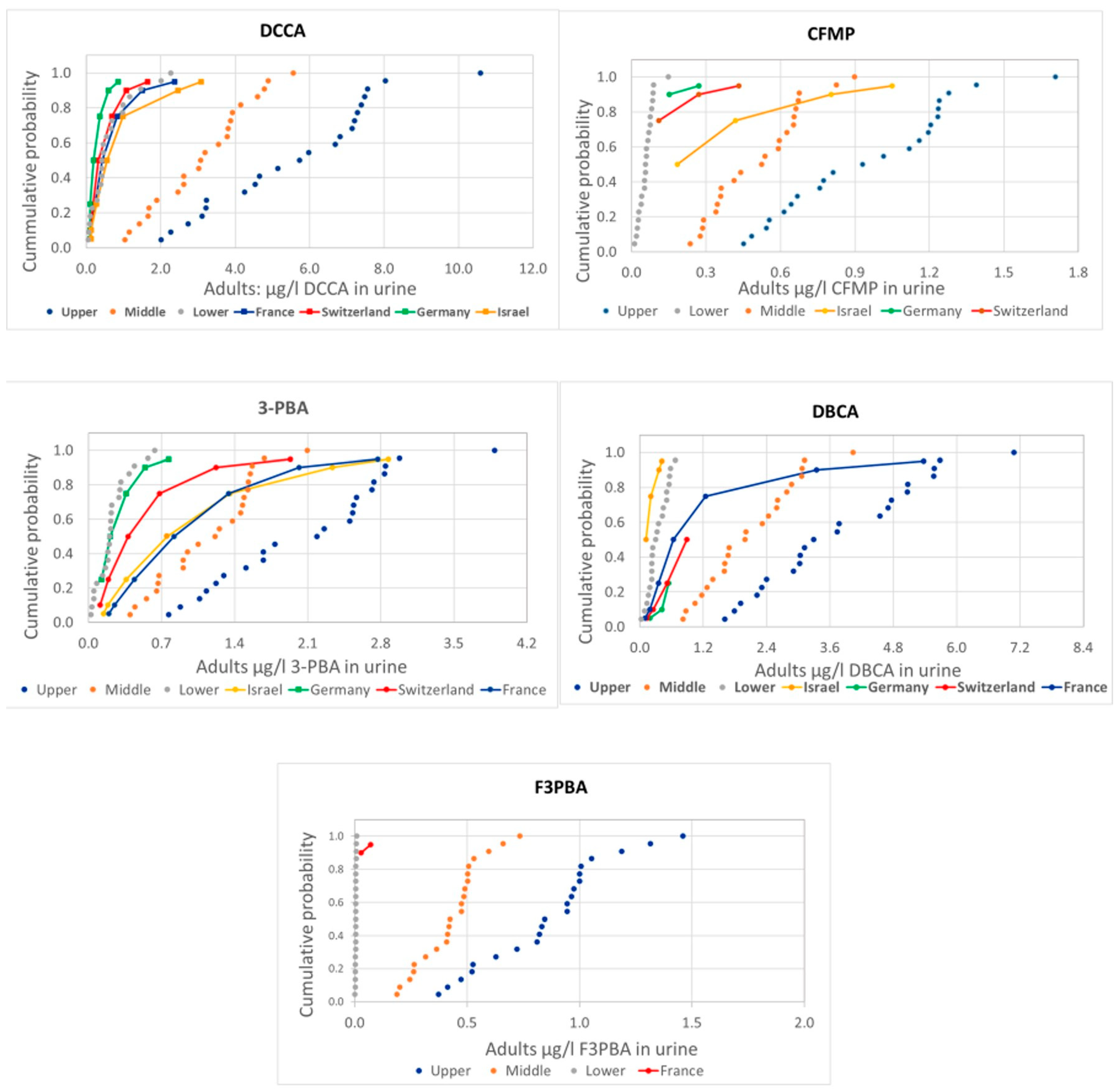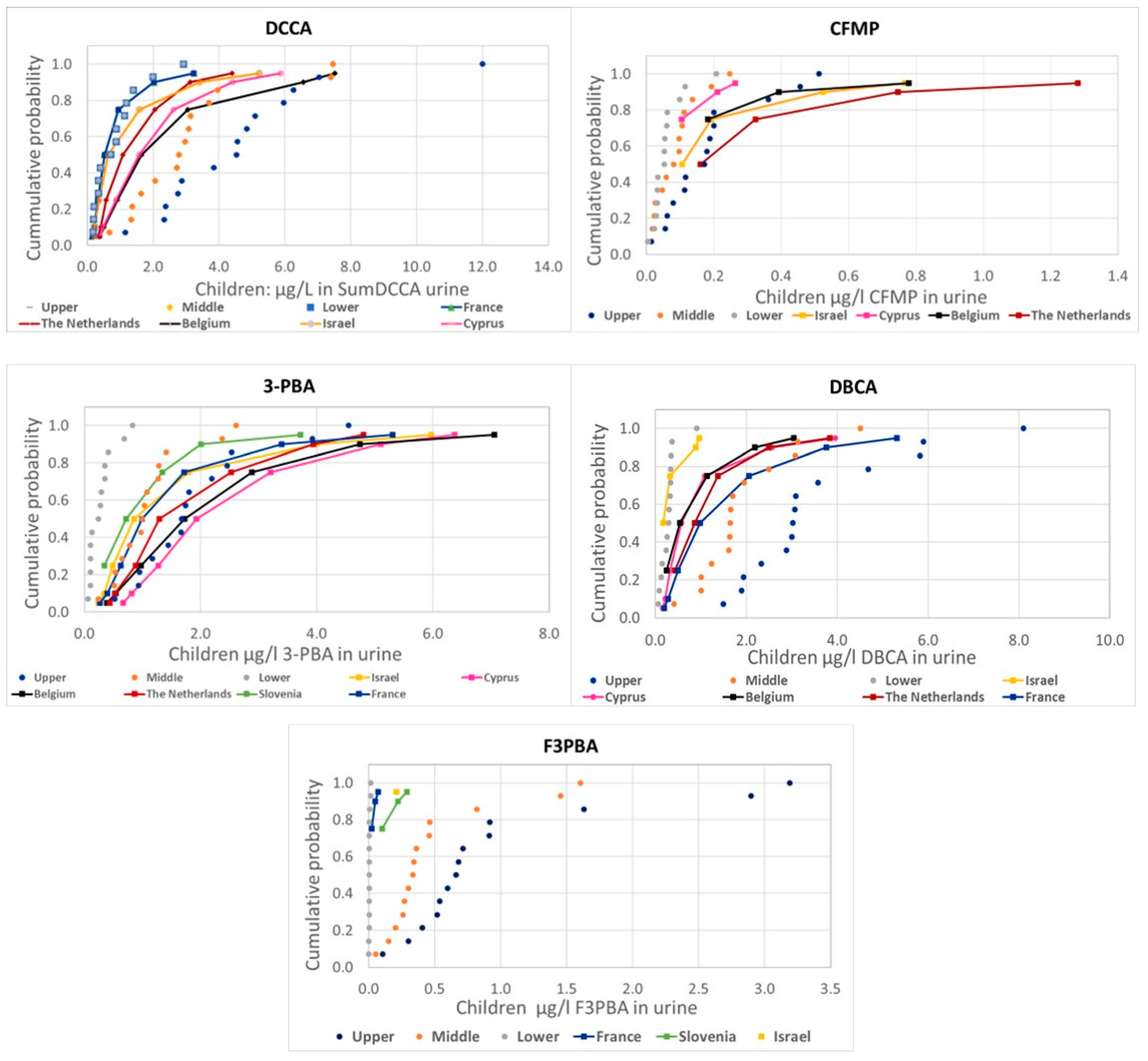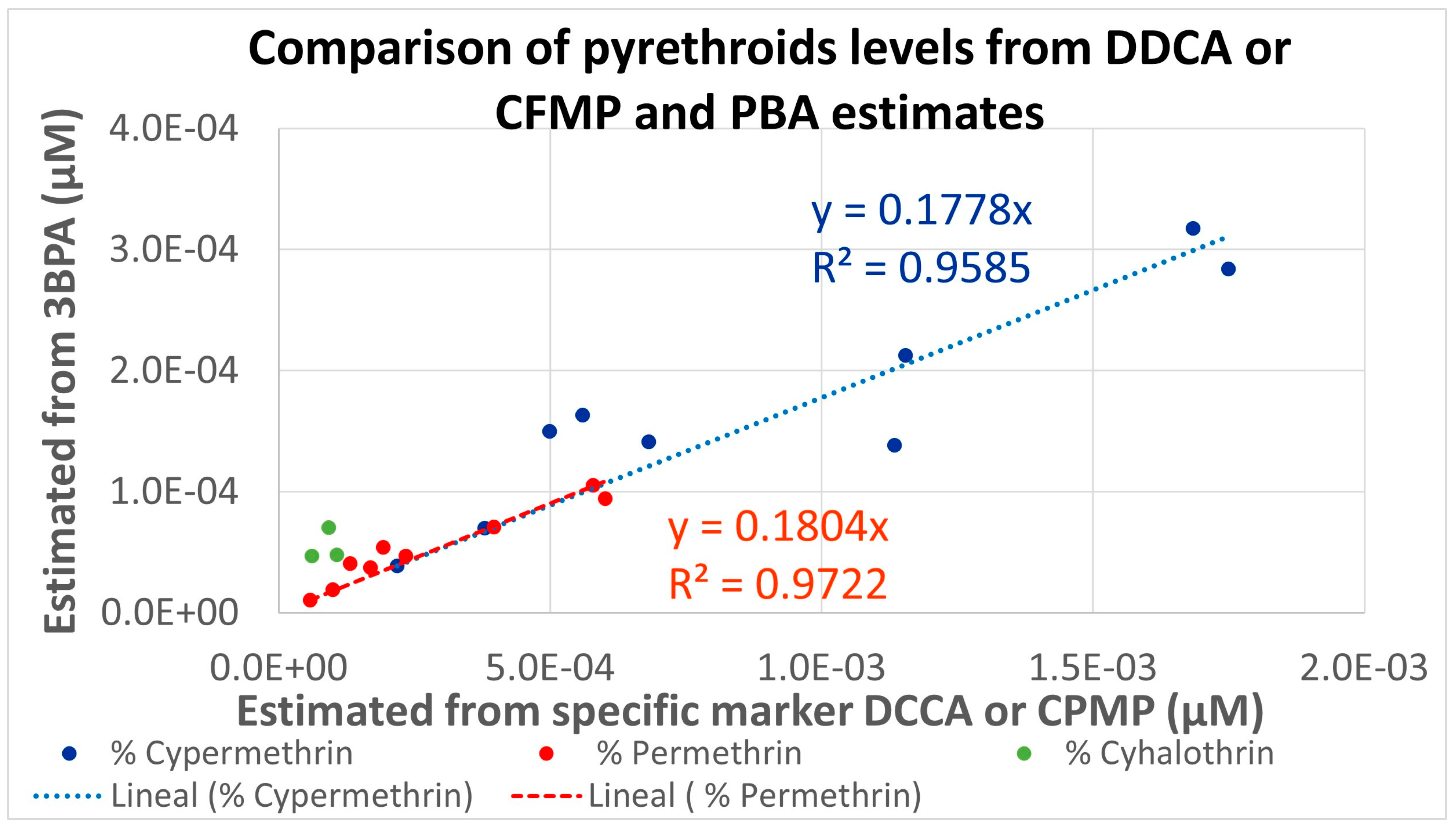Applicability of Food Monitoring Data for Assessing Relative Exposure Contributions of Pyrethroids in Retrospective Human Biomonitoring Risk Estimations
Abstract
:1. Introduction
2. Materials and Methods
2.1. Data Sources
2.2. Data Analysis and Estimation of the Expected Contribution from Each Pyrethroid
2.3. Refined Risk Assessment Estimations
3. Results
3.1. Comparison of Food and Human Monitoring Data
3.2. Estimation of Relative Contributions of Each Pyrethroid to DCCA, CMFP, and 3-BPA
3.3. Estimations of Hazard Quotient for Each Selected Metabolite
4. Discussion
5. Conclusions
Supplementary Materials
Author Contributions
Funding
Institutional Review Board Statement
Data Availability Statement
Acknowledgments
Conflicts of Interest
References
- Hassaan, M.A.; El Nemr, A. Pesticides pollution: Classifications, human health impact, extraction and treatment techniques. Egypt. J. Aquat. Res. 2020, 46, 207–220. [Google Scholar] [CrossRef]
- Zhou, H.R.; Lin, L.W.; Li, Z.R.; Peng, X.R.; Qiu, M.H. Four undescribed pyrethrins from seeds of Pyrethrum cinerariifolium and their aphidicidal activity. Nat. Prod. Bioprospect 2023, 13, 22. [Google Scholar] [CrossRef] [PubMed]
- Boff, J.S.; Reis, A.C.; de Oliveira, J.L.; Gross, R.B.; Fraceto, L.F.; Melo, A.A.; Bernardi, O. Development and biological evaluation of nanoencapsulated-based pyrethroids with synergists for resistance management of two soybean pests: Insights for new insecticide formulations. Pest Manag. Sci. 2023, 79, 1204–1212. [Google Scholar] [CrossRef] [PubMed]
- Gammon, D.W.; Liu, Z.; Chandrasekaran, A.; El-Naggar, S.F.; Kuryshev, Y.A.; Jackson, S. Pyrethroid neurotoxicity studies with bifenthrin indicate a mixed Type I/II mode of action. Pest. Manag. Sci. 2019, 75, 1190–1197. [Google Scholar] [CrossRef] [PubMed]
- Ravula, A.R.; Yenugu, S. Pyrethroid based pesticides—Chemical and biological aspects. Crit. Rev. Toxicol. 2021, 51, 117–140. [Google Scholar] [CrossRef] [PubMed]
- Hao, F.; Bu, Y.; Huang, S.; Li, W.; Feng, H.; Wang, Y. Effects of pyrethroids on the cerebellum and related mechanisms: A narrative review. Crit. Rev. Toxicol. 2023, 53, 229–243. [Google Scholar] [CrossRef] [PubMed]
- Elser, B.A.; Hing, B.; Stevens, H.E. A narrative review of converging evidence addressing developmental toxicity of pyrethroid insecticides. Crit. Rev. Toxicol. 2022, 52, 371–388. [Google Scholar] [CrossRef]
- Gimenez-Asensio, M.J.; Hernandez, A.F.; Romero-Molina, D.; Gonzalez-Alzaga, B.; Luzardo, O.P.; Henríquez-Hernández, L.A.; Boada, L.D.; García-Cortés, H.; Lopez-Flores, I.; Sanchez-Piedra, M.D.; et al. Effect of prenatal exposure to organophosphates and pyrethroid pesticides on neonatal anthropometric measures and gestational age. Environ. Res. 2023, 232, 116410. [Google Scholar] [CrossRef]
- Tarazona, J.V.; Cattaneo, I.; Niemann, L.; Pedraza-Diaz, S.; González-Caballero, M.C.; de Alba-Gonzalez, M.; Cañas, A.; Dominguez-Morueco, N.; Esteban-López, M.; Castaño, A.; et al. A Tiered Approach for Assessing Individual and Combined Risk of Pyrethroids Using Human Biomonitoring Data. Toxics 2022, 10, 451. [Google Scholar] [CrossRef]
- European Food Safety Authority. The 2016 European Union report on pesticide residues in food. EFSA J. 2018, 16, e05348. [Google Scholar] [CrossRef]
- European Food Safety Authority. The 2017 European Union report on pesticide residues in food. EFSA J. 2019, 17, e05743. [Google Scholar] [CrossRef]
- European Food Safety Authority; Cabrera, L.C.; Pastor, P.M. The 2019 European Union report on pesticide residues in food. EFSA J. 2021, 19, e06491. [Google Scholar] [CrossRef]
- European Food Safety Authority; Cabrera, L.C.; Pastor, P.M. The 2020 European Union report on pesticide residues in food. EFSA J. 2022, 20, e07215. [Google Scholar] [CrossRef]
- European Food Safety Authority; Medina-Pastor, P.; Triacchini, G. The 2018 European Union report on pesticide residues in food. EFSA J. 2020, 18, e06057. [Google Scholar] [CrossRef] [PubMed]
- Brancato, A.; Brocca, D.; Ferreira, L.; Greco, L.; Jarrah, S.; Leuschner, R.; Medina, P.; Miron, I.; Nougadere, A.; Pedersen, R.; et al. Use of EFSA Pesticide Residue Intake Model (EFSA PRIMo revision 3). EFSA J. 2018, 16, e05147. [Google Scholar] [CrossRef] [PubMed]
- Tarazona, J.V.; González-Caballero, M.C.; de Alba-Gonzalez, M.; Pedraza-Diaz, S.; Cañas, A.; Dominguez-Morueco, N.; Esteban-López, M.; Cattaneo, I.; Katsonouri, A.; Makris, K.C.; et al. Improving the Risk Assessment of Pesticides through the Integration of Human Biomonitoring and Food Monitoring Data: A Case Study for Chlorpyrifos. Toxics 2022, 10, 313. [Google Scholar] [CrossRef]
- Andersen, H.R.; Rambaud, L.; Riou, M.; Buekers, J.; Remy, S.; Berman, T.; Govarts, E. Exposure Levels of Pyrethroids, Chlorpyrifos and Glyphosate in EU-An Overview of Human Biomonitoring Studies Published since 2000. Toxics 2022, 10, 789. [Google Scholar] [CrossRef]
- Santonen, T.; Mahiout, S.; Alvito, P.; Apel, P.; Bessems, J.; Bil, W.; Borges, T.; Bose-O’Reilly, S.; Buekers, J.; Cañas Portilla, A.I.; et al. How to use human biomonitoring in chemical risk assessment: Methodological aspects, recommendations, and lessons learned from HBM4EU. Int. J. Hyg. Environ. Health 2023, 249, 114139. [Google Scholar] [CrossRef]
- Aylward, L.L.; Irwin, K.; St-Amand, A.; Nong, A.; Hays, S.M. Screening-level Biomonitoring Equivalents for tiered interpretation of urinary 3-phenoxybenzoic acid (3-PBA) in a risk assessment context. Regul. Toxicol. Pharmacol. 2018, 92, 29–38. [Google Scholar] [CrossRef]
- Šulc, L.; Figueiredo, D.; Huss, A.; Kalina, J.; Gregor, P.; Janoš, T.; Šenk, P.; Dalecká, A.; Andrýsková, L.; Kodeš, V.; et al. Current-use pesticide exposure pathways in Czech adults and children from the CELSPAC-SPECIMEn cohort. Environ. Int. 2023, 181, 108297. [Google Scholar] [CrossRef]
- Ioannidou, S.; Cascio, C.; Gilsenan, M.B. European Food Safety Authority open access tools to estimate dietary exposure to food chemicals. Environ. Int. 2021, 149, 106357. [Google Scholar] [CrossRef] [PubMed]
- Quindroit, P.; Beaudouin, R.; Brochot, C. Estimating the cumulative human exposures to pyrethroids by combined multi-route PBPK models: Application to the French population. Toxicol. Lett. 2019, 312, 125–138. [Google Scholar] [CrossRef] [PubMed]
- Vanacker, M.; Quindroit, P.; Angeli, K.; Mandin, C.; Glorennec, P.; Brochot, C.; Crépet, A. Aggregate and cumulative chronic risk assessment for pyrethroids in the French adult population. Food Chem. Toxicol. 2020, 143, 111519. [Google Scholar] [CrossRef] [PubMed]
- Willenbockel, C.T.; Prinz, J.; Dietrich, S.; Marx-Stoelting, P.; Weikert, C.; Tralau, T.; Niemann, L. A Critical Scoping Review of Pesticide Exposure Biomonitoring Studies in Overhead Cultures. Toxics 2022, 10, 170. [Google Scholar] [CrossRef]
- Bossou, Y.M.; Côté, J.; Morin, É.; Dumais, É.; Bianchi, C.; Bouchard, M. Assessing the impact of coexposure on the measurement of biomarkers of exposure to the pyrethroid lambda-cyhalothrin in agricultural workers. Int. J. Hyg. Environ. Health 2023, 251, 114194. [Google Scholar] [CrossRef] [PubMed]
- Bossou, Y.M.; Côté, J.; Mantha, M.; Haddad, S.; Achard, S.; Bouchard, M. Impact of pesticide coexposure: An experimental study with binary mixtures of lambda-cyhalothrin (LCT) and captan and its impact on the toxicokinetics of LCT biomarkers of exposure. Arch. Toxicol. 2020, 94, 3045–3058. [Google Scholar] [CrossRef] [PubMed]
- Quindroit, P.; Crépet, A.; Brochot, C. Estimating human exposure to pyrethroids’ mixtures from biomonitoring data using physiologically based pharmacokinetic modeling. Environ. Res. 2021, 192, 110281. [Google Scholar] [CrossRef]
- Merten, C.; Ferrari, P.; Bakker, M.; Boss, A.; Hearty, A.; Leclercq, C.; Lindtner, O.; Tlustos, C.; Verger, P.; Volatier, J.L.; et al. Methodological characteristics of the national dietary surveys carried out in the European Union as included in the European Food Safety Authority (EFSA) Comprehensive European Food Consumption Database. Food Addit. Contam. Part A Chem. Anal. Control Expo. Risk Assess. 2011, 28, 975–995. [Google Scholar] [CrossRef]
- Claeys, W.L.; De Voghel, S.; Schmit, J.F.; Vromman, V.; Pussemier, L. Exposure assessment of the Belgian population to pesticide residues through fruit and vegetable consumption. Food Addit. Contam. Part A Chem. Anal. Control Expo. Risk Assess. 2008, 25, 851–863. [Google Scholar] [CrossRef]
- Valcke, M.; Bourgault, M.H.; Rochette, L.; Normandin, L.; Samuel, O.; Belleville, D.; Blanchet, C.; Phaneuf, D. Human health risk assessment on the consumption of fruits and vegetables containing residual pesticides: A cancer and non-cancer risk/benefit perspective. Environ. Int. 2017, 108, 63–74. [Google Scholar] [CrossRef]
- Drouillet-Pinard, P.; Boisset, M.; Periquet, A.; Lecerf, J.M.; Casse, F.; Catteau, M.; Barnat, S. Realistic approach of pesticide residues and French consumer exposure within fruit & vegetable intake. J. Environ. Sci. Health B 2011, 46, 84–91. [Google Scholar] [CrossRef] [PubMed]
- Authority, E.F.S.; Craig, P.S.; Dujardin, B.; Hart, A.; Hernández-Jerez, A.F.; Hougaard Bennekou, S.; Kneuer, C.; Ossendorp, B.; Pedersen, R.; Wolterink, G.; et al. Cumulative dietary risk characterisation of pesticides that have acute effects on the nervous system. EFSA J. 2020, 18, e06087. [Google Scholar] [CrossRef]
- Grosssteiner, I.; Mienne, A.; Lucas, L.; L-Yvonnet, P.; Trenteseaux, C.; Fontaine, K.; Sarda, X. Cumulative risk assessment with pesticides in the framework of MRL setting. EFSA J. 2023, 21, e211009. [Google Scholar] [CrossRef] [PubMed]





| Active Substance | ADI | Mw | 1st Metabolite | Mw | Fue | 2nd Metabolite | Mw | Fue |
|---|---|---|---|---|---|---|---|---|
| Deltamethrin | 0.01 | 505.2 | DBCA | 298.0 | 0.45 | 3PBA | 214.2 | 0.09 |
| Cyfluthrin | 0.01 | 434.3 | DCCA | 208.1 | 0.36 | 4-F3PBA | 232.2 | 0.47 |
| Cypermethrin | 0.005 | 416.3 | DCCA | 208.1 | 0.36 | 3PBA | 214.2 | 0.09 |
| λ cyhalothrin | 0.0025 | 449.9 | CFMP * | 242.6 | 0.21 | 3PBA | 214.2 | 0.09 |
| Bifenthrin | 0.015 | 422.9 | CFMP * | 242.6 | 0.21 | |||
| Permethrin | 0.05 | 391.2 | DCCA | 208.1 | 0.36 | 3PBA | 214.2 | 0.09 |
| DCCA | DCCA | DCCA | CFMP | CFMP | 3-PBA | 3-PBA | 3-PBA | 3-PBA | |
|---|---|---|---|---|---|---|---|---|---|
| % Cyfluthrin | % Cypermethrin | % Permethrin | % Cyhalothrin | % Bifenthrin | % Cyhalothrin | % Deltamethrin | % Cypermethrin | % Permethrin | |
| Adults | |||||||||
| P10th | 4.71 | 49.80 | 8.35 | 53.67 | 23.78 | 5.81 | 22.60 | 29.79 | 5.14 |
| P50th | 12.69 | 66.31 | 17.44 | 66.93 | 33.07 | 15.01 | 28.64 | 43.60 | 11.79 |
| P90th | 20.66 | 85.14 | 31.53 | 76.22 | 46.33 | 19.98 | 36.15 | 61.41 | 18.44 |
| Children | |||||||||
| P10th | 4.94 | 20.58 | 8.52 | 52.08 | 24.25 | 5.34 | 13.45 | 16.51 | 6.17 |
| P50th | 12.69 | 61.56 | 21.15 | 66.06 | 33.94 | 12.95 | 29.04 | 39.21 | 13.02 |
| P90th | 21.57 | 85.55 | 73.06 | 75.75 | 47.92 | 20.13 | 38.80 | 62.20 | 61.80 |
Disclaimer/Publisher’s Note: The statements, opinions and data contained in all publications are solely those of the individual author(s) and contributor(s) and not of MDPI and/or the editor(s). MDPI and/or the editor(s) disclaim responsibility for any injury to people or property resulting from any ideas, methods, instructions or products referred to in the content. |
© 2023 by the authors. Licensee MDPI, Basel, Switzerland. This article is an open access article distributed under the terms and conditions of the Creative Commons Attribution (CC BY) license (https://creativecommons.org/licenses/by/4.0/).
Share and Cite
de Alba-Gonzalez, M.; González-Caballero, M.C.; Tarazona, J.V. Applicability of Food Monitoring Data for Assessing Relative Exposure Contributions of Pyrethroids in Retrospective Human Biomonitoring Risk Estimations. Toxics 2024, 12, 24. https://doi.org/10.3390/toxics12010024
de Alba-Gonzalez M, González-Caballero MC, Tarazona JV. Applicability of Food Monitoring Data for Assessing Relative Exposure Contributions of Pyrethroids in Retrospective Human Biomonitoring Risk Estimations. Toxics. 2024; 12(1):24. https://doi.org/10.3390/toxics12010024
Chicago/Turabian Stylede Alba-Gonzalez, Mercedes, Maria Carmen González-Caballero, and Jose V. Tarazona. 2024. "Applicability of Food Monitoring Data for Assessing Relative Exposure Contributions of Pyrethroids in Retrospective Human Biomonitoring Risk Estimations" Toxics 12, no. 1: 24. https://doi.org/10.3390/toxics12010024






